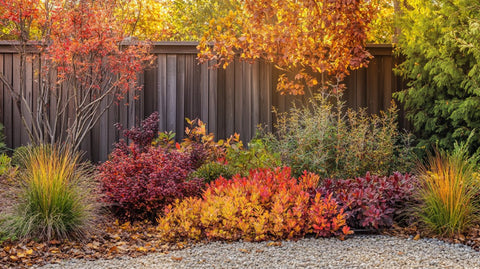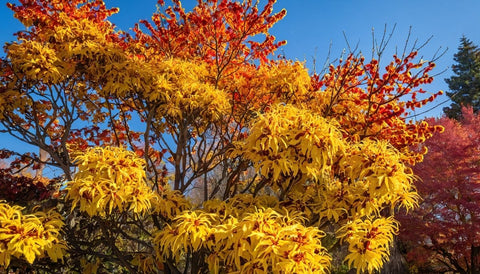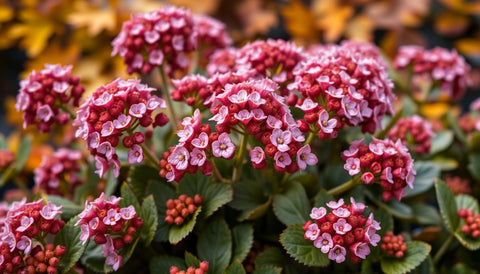Welcome to our guide on creating a fall garden with native shrubs, where we'll help you turn your outdoor space into a vibrant and sustainable sanctuary. Gardening in the fall might seem unconventional, but it brings its own unique charm and benefits. Not only do native shrubs contribute to a healthier ecosystem, but they also provide stunning fall colors and support local wildlife. In this post, we'll cover everything from the advantages of native plants to the best practices for planting and maintaining your garden. Ready to dig in? Let’s get started!

Why Choose Native Shrubs?
Native shrubs are the unsung heroes of landscaping. By definition, these are plants that have evolved in a specific region and are well-adapted to the local climate and soil conditions. But why should you consider them for your fall garden? Hold on to your gardening gloves—here are some compelling reasons:
- Adaptability: Native shrubs thrive in their local environment, requiring less water and fertilizer compared to non-native species. This translates to lower maintenance and a healthier garden.
- Wildlife Support: By incorporating these plants, you’re providing essential habitats and food sources for local wildlife, including pollinators and birds. For instance, hollow stems serve as homes for solitary bees!
- Biodiversity Boost: Increasing the diversity of plants in your garden contributes to more resilient ecosystems. Native shrubs can help maintain the balance of local flora and fauna.
Now that you see the perks, let’s jump into the planning phase!

Planning Your Fall Garden
Assessing Space and Sunlight
Before you get carried away with green dreams, take a moment to evaluate your space. Check how much sunlight your garden gets throughout the day. Different shrubs have different light requirements, so this step is crucial.
Soil Testing and Amendments
Healthy soil is the foundation of any thriving garden. Conduct a soil test to understand the pH and nutrient levels. Depending on the results, you might want to amend your soil with compost or organic matter to enhance its fertility.
Designing Your Layout
Alright, it’s time to unleash your inner landscape architect! Here are a few design tips:
- Layering Plants: Create visual interest by layering shrubs of varying heights. Taller species can be placed in the back, while shorter ones fill in the front.
- Seasonal Interest: Choose shrubs that offer vibrant fall colors or unique textures. Think about how your garden will look not just now, but through the winter months too!
- Wildlife-Friendly Spaces: Incorporate small sheltered areas or plant more densely to create habitats that attract local birds and pollinators.
Select Native Shrubs for Your Garden
Now, the fun part—choosing your native shrubs! Here are five superb options that will elevate your fall garden:
- Dogwood (Cornus spp.): This shrub offers stunning fall color and striking red berries that are loved by birds.
- Beautyberry (Callicarpa americana): If you're looking for a pop of color, this shrub’s purple berries in late summer will catch anyone’s eye.
- Winterberry (Ilex verticillata): As the name suggests, winterberry holds bright red berries that persist through the cold months.
- Ninebark (Physocarpus opulifolius): This shrub boasts textured bark and colorful foliage, perfect for adding depth to your garden.
- Sumac (Rhus spp.): Famous for its vibrant red and orange foliage in fall, sumac will steal the show in your landscape.
Want to acquire these beauties? Don’t forget to check out your local nurseries and native plant sales—they often have the best selections!
Preparing and Planting
Best Practices for Planting Shrubs in Fall
You might be wondering, “Is fall really the right time to plant?” Absolutely! Fall is perfect because it allows shrubs to establish roots before winter. Here’s how to prepare:
- Timing: Aim to plant in early fall or after the first frost when temperatures cool down.
- Soil Preparation: Ensure the soil is not too wet or dry. Mix in compost to enrich the soil.
-
Proper Planting Techniques: Follow these guidelines when planting:
- Depth: Make sure to plant at the same depth as it was in the nursery.
- Spacing: Give your plants enough room to grow. Generally, shrubs need about 3 to 6 feet of space apart.
- Watering: Water thoroughly after planting, and continue to keep the soil moist (but not soggy) until the first frost.

Caring for Your Fall Garden
Winterizing Your Garden
Once your shrubs are planted, it’s time to think about winter preparation. Here’s how to keep your garden thriving through the colder months:
- Mulching: Apply a generous layer of mulch around your shrubs. This helps retain moisture, suppress weeds, and regulate soil temperature.
- Pruning Guidelines: Prune dead or damaged branches, but hold off on heavy pruning until late winter or early spring.
- Watering and Fertilizing: As temperatures drop, maintain a careful watering schedule. Avoid fertilizing late in fall so plants have time to prepare for dormancy.
Encouraging Wildlife and Biodiversity
By focusing on native shrubs, you’re enhancing biodiversity in your garden without heavy lifting. Here are a few tips to encourage more wildlife visits:
- Plant a diverse range of species to attract a variety of pollinators.
- Create sheltered spots, like rock piles or brush piles, for wildlife habitat.
Enjoying Your Fall Garden
Appreciate the Beauty
Your gardening journey doesn't just stop at planting. Here are some fun activities to enjoy your fall garden:
- Photography: Grab your camera or smartphone to capture the rich hues of fall. A sunrise or sunset backdrop can make those colors pop!
- Family Outings: Use your garden as a venue for family picnics or casual gatherings. It’s a great way to appreciate the fruits of your labor.
- Wildlife-Friendly Events: Host nature walks or “garden observations” with friends to share your gardening passion and insights.

Promote Ecological Responsibility
Gardening is more than aesthetics; it's a commitment to fostering our environment. Each native shrub planted contributes to a stronger ecosystem and a healthier planet.
Conclusion
Creating a fall garden with native shrubs is not just about beautifying your yard—it's about nurturing the environment and embracing the changing seasons. With a little planning, selection, and care, you can cultivate a space that supports wildlife and adds vibrant colors to your landscape. So why wait? Dive into the joys of sustainable gardening today!
Share Your Experience!
We'd love to hear about your experiences with native shrub gardening! Share your thoughts, tips, or even photos of your garden in the comments below.
Additional Resources
- Local Native Plant Societies
- Suggested Readings on Native Plants
- Garden Design Workshops and Community Events
Stay Connected
Don’t forget to subscribe for more gardening tips and native planting ideas. If you found this guide helpful, share it on your social media and spread the green love!






























Comments (0)
There are no comments for this article. Be the first one to leave a message!